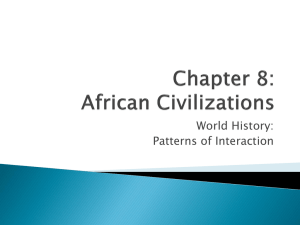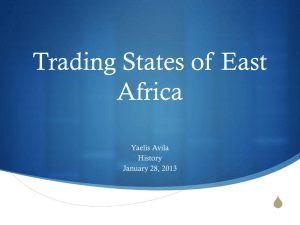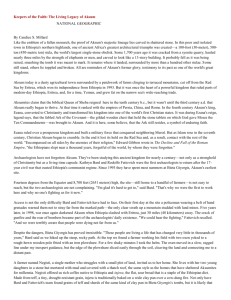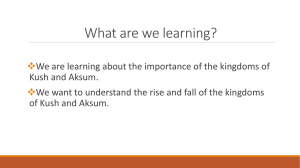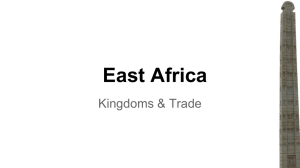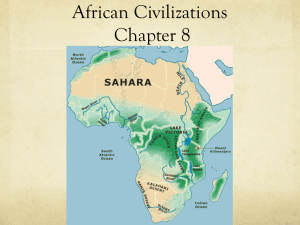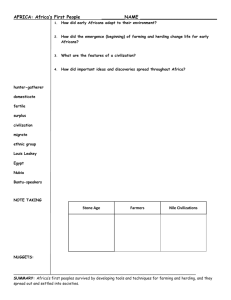The Kingdom of Aksum
advertisement
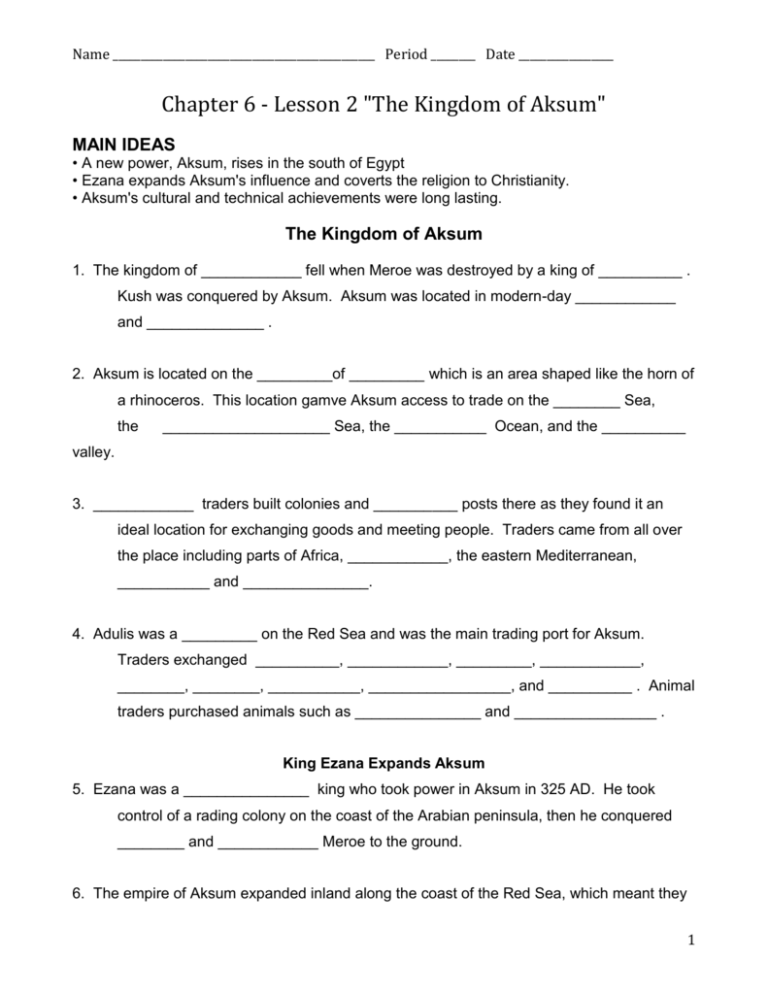
Name _______________________________________________ Period ________ Date _________________ Chapter 6 - Lesson 2 "The Kingdom of Aksum" MAIN IDEAS • A new power, Aksum, rises in the south of Egypt • Ezana expands Aksum's influence and coverts the religion to Christianity. • Aksum's cultural and technical achievements were long lasting. The Kingdom of Aksum 1. The kingdom of ____________ fell when Meroe was destroyed by a king of __________ . Kush was conquered by Aksum. Aksum was located in modern-day ____________ and ______________ . 2. Aksum is located on the _________of _________ which is an area shaped like the horn of a rhinoceros. This location gamve Aksum access to trade on the ________ Sea, the ____________________ Sea, the ___________ Ocean, and the __________ valley. 3. ____________ traders built colonies and __________ posts there as they found it an ideal location for exchanging goods and meeting people. Traders came from all over the place including parts of Africa, ____________, the eastern Mediterranean, ___________ and _______________. 4. Adulis was a _________ on the Red Sea and was the main trading port for Aksum. Traders exchanged __________, ____________, _________, ____________, ________, ________, ___________, _________________, and __________ . Animal traders purchased animals such as _______________ and _________________ . King Ezana Expands Aksum 5. Ezana was a _______________ king who took power in Aksum in 325 AD. He took control of a rading colony on the coast of the Arabian peninsula, then he conquered ________ and ____________ Meroe to the ground. 6. The empire of Aksum expanded inland along the coast of the Red Sea, which meant they 1 Name _______________________________________________ Period ________ Date _________________ controlled a large _________________ network. 7. Ezana became king when he was an ____________. While he was being educated, Ezana's mother ruled on his behalf. One of his teachers taught him about ________________. When Ezana began to rule he ________________ to Christianity. He made ____________________ the official religion of Aksum. Aksum's Achievements 8. Aksum combined the culture form the various cultures that traded around the Horn of Africa. Among the most impressive of the achievements were the ____________ of Aksum. Builders placed these pillars around the country. The pillars were 60-100 feet tall and had writings on them that celebrated great ____________ and ____________. Something special and different about these pillars were that they were made from ______ slab of stone. 9. Builders and architects also built large _______________. Later, Christian ____________ replaced the temples. 10. Aksum had a written language called __________ which was a language that the Arabian migrants brought to Aksum. Geez became the basis for __________ languages that are used in Ethiopia and Eritrea today. 11. The landscape of Aksum was _________________ and hilly. To adapt the land for farming, farmers built ___________________ which are leveled off areas of land which holds moisture better than hilly land does. Terraced farming ______________ the amount of land that could be farmed. Farmers in Aksum also built ___________, __________, and ________________ to bring _______________ water to the fields. 12. Many Ethiopians today are ______________________, the religion of King _________ . 2 Name _______________________________________________ Period ________ Date _________________ Word (Term, person or place) Definition (in your own words) Icon/Picture Application: Which learning target goes with this word? What's the connection? LT # Aksum p.197 LT # Horn of Africa p.197 LT # Adulis p.198 Enzana p.198 terrace p. 200 3 Name _______________________________________________ Period ________ Date _________________ History Makers: Ezana: King of Aksum King Ezana ruled Aksum during the fourth century A.D. He became a Christian and made Christianity the official religion of his kingdom. King Ezana ruled the African kingdom of Aksum from A.D. 325 to 360. His kingdomwas large. It extended throughout much of what is now Ethiopia. He also may have had influence in the Arabian kingdom now known as Yemen. It is even possible that Ezana had a foothold across the Red Sea in Yemen. In any case, Ezana’s reign occurred at the beginning of Aksum’s period of greatest power, from the fourth through the sixth century A.D. Ezana’s Coins Much of what historians know about ancient Aksum comes from one of two sources—stone pillars, called steles, and coins. Aksum minted coins during a period of about 300 years. It was the only African civilization to do so. Although an earlier Aksumite king named Endubis was the first to produce coins, Ezana was the first to mint coins bearing the Christian symbol of a cross. The cross replaced the crescent that appeared on earlier coins. The crescent may have represented the god of the sun or the moon. The use of the cross reflected Ezana’s desire to spread Christianity. Conversion to Christianity Sometime between A.D. 330 and 440, Ezana became a Christian. He also made Christianity the official state religion. This was perhaps his most important contribution to Ethiopian culture. The story of Ezana’s conversion is told by Rufinius, a fourth-century historian. According to Rufinius, two Syrian boys —Frumentius and Aedesius—grew up in thecourt of King Ella Amida, Ezana’s father. The boys had been aboard a trading ship that was seized in the Red Sea. They somehow survived the incident and were taken to Ella Amida. The king treated them kindly and, as they got older, gave them official tasks to perform. When the boys were grown, Ella Amida also granted them their freedom. Soon afterwards he died, leaving Ezana as his only heir. At that time, Ezana was only an infant. His mother turned to the two Syrians for assistance. She asked them to remain at court until her son was old enough to rule. Frumentius was especially loyal and honest. He also was a Christian and promoted Christianity. One way he did this was to seek out and assist Christian traders. After Ezana became king, Frumentius traveled to Alexandria. He asked the head of the Eastern Orthodox Church to send a bishop to Aksum. Instead, Frumentius was appointed bishop. He returned to the kingdom as Ethiopia’s first Christian bishop. The influence of Frumentius led to Ezana’s conversion to Christianity. Ezana is also linked to the Ark of the Covenant, which is sacred to both Jews and Christians. The Ark was the cabinet built to contain the stone tablets that God gave to Moses. The Ten Commandments were written on the tablets. According to the Torah (the Hebrew Bible), the Ten Commandments were part of an agreement, or covenant, between God and the Hebrews. They form the basis of the Jewish religion and are also honored by Christians. During the reign of King Solomon of Israel, the Ark of the Covenant disappeared from Jerusalem’s temple. There is more than one version of how this happened, but they all center around Menelik. According to one legend, Menelik was the son of King Solomon and Sheba, the queen of Ethiopia. Menelik, while a young man, spent three years with his father in Jerusalem. When Menelik returned to 4 Name _______________________________________________ Period ________ Date _________________ Aksum, many people accompanied him. One of them was Azariah, whose father was the high priest of the temple of Jerusalem. Before leaving Jerusalem, Azariah had a dream telling him to take the Ark of the Covenant to Ethiopia. Then Azariah stole the Ark and replaced it with a copy. When Solomon found out, he tried to recover the Ark. Then he too had a dream, telling him that the Ark should stay with Menelik. This supposedly happened many hundreds of years before Ezana’s reign. What happened to the Ark of the Covenant after Menelik arrived in Ethiopia is still unknown. However, it appears that the Ark may have been brought to Aksum during Ezana’s reign. Many believe that the Ark is now being kept at Saint Mary’s of Zion, a church established by Ezana. In 1965, Ethiopian emperor Haile Selassie had a small chapel built at St. Mary’s to house the Ark. A guardian of the Ark is chosen from among the monks living in the compound at Saint Mary’s. He is the only person who may enter the chapel. The Ark of the Covenant has become important in the Ethiopian Christian tradition. Many of the country’s churches contain a replica of the Ark. Ezana’s Inscriptions Like many rulers of ancient kingdoms, Ezana had his deeds inscribed on stone pillars, or steles. A group of about 50 steles are located on the northern edge of Aksum. Some date back to prehistoric times. At 24 metres (78.74 feet), King Ezana’s is the tallest one still standing. The stele of King Ezana is one of several carved to look like tall buildings. Although Aksum’s buildings were not nearly as high as the pillars, their doors and windows probably looked much like those carved in the stele. Carved square beam-ends resemble the wooden beams used in Aksumite construction. The stele is inscribed in three languages— Greek, Sabaean, and Ge´ez, the language spoken in Axsum. Sabaean is a language once spoken in southwestern Arabia. The Greeks were known to trade with Aksum, which may explain the use of Greek. Ezana used the traditional title negusa nagast, meaning “king of kings,” to show that he ruled over the heads of many small states. The inscription describes his victory over rebellious peoples. 1. What ancient kingdom did Ezana rule? 2. How have historians learned about Ezana’s reign? 3. What change did Ezana make to the coins of Aksum? Why? 4. Why did Ezana and other ancient kings tell of their military victories in stone inscriptions? 5. What lasting effect did Ezana have on Ethiopian culture? 5
